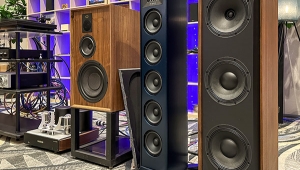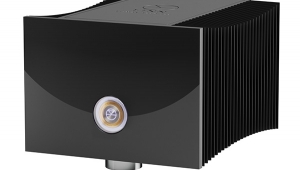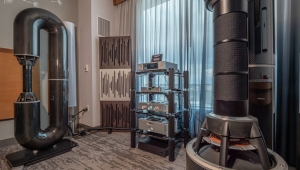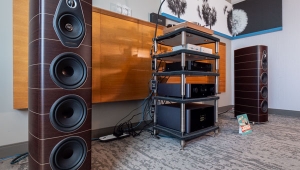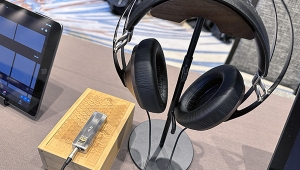| Columns Retired Columns & Blogs |
Fujitsu Ten Eclipse TD712z loudspeaker
All right, it's time for a pop quiz in Loudspeaker Design 101. Answer the following, and justify your answer.
Footnote 1: Coaxial and triaxial drivers don't count. These still have a separate woofer and tweeter, or woofer, midrange, and tweeter; they're just mounted in a different way.
What is the ideal number of drivers in a loudspeaker system?
a) two
b) three
c) four or more
d) none of the above
You have your answer? Good. Next question:
What is the best type of crossover in a loudspeaker system?
a) first order (6dB/octave)
b) second order (12dB)
c) third order (18dB)
d) fourth order (24dB) or higher
e) none of the above
Got that one, too? Well, if you've noticed what kind of speaker is being reviewed here, you've probably figured out that the answers to these questions are d) and e): "none of the above." The ideal number of drivers in a system is one, and the ideal crossover is none—that is, if that single driver is able to reproduce the entire frequency range without neglecting or emphasizing any part of the range, has sufficiently low distortion throughout the range, can play loud enough to produce satisfying sound levels, and has no other anomalies, such as a highly restricted or uneven radiation pattern.

Alas, these are major qualifications, and most loudspeaker designers have decided that there are simply too many difficulties and compromises in producing a single-driver speaker. So most speakers on the market use multiple drivers and a variety of crossover configurations, and arguments continue about which crossover design is best.
However, some brave souls are devoted to the design and manufacture of full-range, single-driver speakers (footnote 1), the most notable of these being Lowther, which has a fan in our own Art Dudley. Lowther is primarily a manufacturer of drive-units, with other companies using their drivers in complete speaker systems (usually horn-loaded enclosures). Lowther's highly efficient drivers feature a "whizzer cone" that provides a kind of mechanical crossover for high frequencies, and some of them have an equalizer phase plug.
Fujitsu Ten is a relatively new entrant in the world of single-driver speaker systems, and I must admit that these speakers at first flew under my audiophile radar. I first encountered the Fujitsu Ten Eclipse TD712z at the 2006 Consumer Electronics Show (actually, at the concurrent T.H.E. Show), and was most impressed with the sound (see ). I was interested in reviewing the speaker, but at the time it was available from only two dealers in the US, not the five required by Stereophile's editorial policy. However, a few weeks later I received an e-mail from Mickey Tachibana, North American representative for Fujitsu Ten Eclipse, stating that the line had been picked up by three more dealers. The review was on, and in due course I received a pair of TD712z's—the same pair that had been demoed in Las Vegas.
Description and Design
As a glance at the photo accompanying this review shows—saving me a thousand words of description—the TD712z looks nothing like your typical box loudspeaker. A single 4.7" driver with a glass-fiber cone is mounted in an egg-shaped enclosure of artificial marble, with a rear-facing port 1.5" in diameter. The speaker comes with a matching sand-filled stand; the interface between speaker and stand has a bolt in the front that permits adjustment of the vertical angle. The stand has four adjustable feet, but, contrary to common audiophile practice, the feet don't end in spikes but in flat bottoms. Speaker and stand have the kind of automotive finish you might expect from Mercedes or Lexus, and the look is sleek and streamlined; the TD712z could be used as part of the set decoration in a movie set some time in the future. In fact, it won Japan's Good Design Award in 2005.
The eggshell construction is designed to distribute mechanical stresses, and its lack of parallel walls functions to minimize any distinct "cabinet sound." However, this is only one of the notable aspects of the TD712z's mechanical design. The driver is not actually attached to the baffle but to five mechanical stays directly attached to the pedestal and extending outward to the edge of the unit, thus creating a floating structure in which driver and enclosure are mechanically separated.
Of course, there has to be something that stops the driver from flopping around when the cone is going back and forth to produce sound; in the TD712z it's a 7.3-lb iron weight called the Grand Anchor. According to Fujitsu Ten, this allows the driver's diaphragm to exhibit ideal piston action. The TD712z differs from the less expensive model 512 in that its stays are made of zinc diffusion, which has three times the specific gravity of the aluminum used in the 512 and thus provides better damping. The vibrational mass of the TD712z driver is 10% lower than the 512's, and there is a 20% increase in magnet flux density. These differences are reflected in the specifications: a frequency response of 40Hz–17kHz and a sensitivity of 81.5dB for the 512, and 40Hz–20kHz and 83.5dB, respectively, for the TD712z. A sensitivity of 83.5dB is still below average for an audiophile speaker, but it compares favorably with the 82.5dB of the famed BBC LS3/5a.
The TD712z is the brainchild of Fujitsu Ten engineer Hiroshi Kowaki, who drew on the speaker-design theories of Hiroyuki Yoshii of the Time Domain Corporation. In a phone conversation, Kowaki told me the story of how the design of the TD712z and other Eclipse TD speakers came about.
Kowaki was trained as an electrical engineer and has a strong background in digital signal processing (DSP). His initial thinking was that he could develop the perfect loudspeaker by measuring the impulse response of a speaker and designing a Finite Impulse Response (FIR) inverse filter that canceled out the irregularities in the impulse response. He pursued this approach for some time, but eventually concluded that it couldn't be made to work: the "corrected" speaker measured quite well but just didn't sound right.
Kowaki abandoned the DSP-based approach and turned his attention to developing speakers that would produce excellent impulse response through the reduction of mechanical resonances in the driver and enclosure. The stated aim of Fujitsu Ten's Eclipse TD line of speakers is to produce "Authentic Waveform Reproduction," which depends critically on the timing of different components of the waveform. According to Kowaki, the measure that relates most directly to this capability is the impulse response, and he feels that focusing on getting the frequency response to be more linear may actually impair the impulse response. He suggests that while multiple-driver systems may have some advantages for achieving linearity of frequency response, a single-driver system, which by definition eliminates the potential waveform-distorting effects of crossovers, has the greatest potential for accurate waveform reproduction. The TD712z is the top model from Fujitsu Ten to embody this approach.
Setup
Setting up the Eclipse TD712z was surprisingly easy. The speaker enclosure fits precisely on the stand, secured by three bolts, and there's a template supplied to help set the angular adjustment bolt. I set this at level (0°), which seemed to work well, the sound achieving its best focus at my normal listening position—so I didn't fiddle with it. The feet are simple to adjust, and the lack of spikes means that the speaker can be moved around quite easily to find the right position.
In my room, those positions were pretty much the same as for other speakers I've had there, the Eclipses forming a more or less equilateral triangle with my listening position and aimed at me (not straight ahead). I like to use a laser pointer to aim speakers, making sure that the left and right cabinets are pointed at my left and right ear, respectively—but the TD712z's curved surfaces didn't permit consistent positioning of the laser pointer. I had to eyeball the alignment, closing each eye to judge whether the speaker was pointed right at me. The Eclipses didn't seem overly sensitive to positioning.
I used three amplifiers with the Eclipses: the Audiopax Model 88 and PrimaLuna ProLogue Seven monoblock tube amplifiers, and the PS Audio GCC-100 "digital" integrated amplifier. The TD712z was highly revealing of amplifier differences—the character of each of these amps was immediately apparent on switchover. In different ways, all three amplifiers were good matches, but my overall favorite was the PrimaLuna, which had much (not all) of the sweetness of the Audiopax, but with better bass and a more authoritative sound. The combination of the TD712z's relatively low sensitivity and the PrimaLunas' extra power might have been a factor here. My comments about the Eclipse's sound refer to this combination.
Sound
I'll get the negatives out of the way first: The Eclipse TD712z wouldn't play very loud and didn't go very low. And that was it.
As I played a variety of CDs and LPs, the system with the Eclipses had a clarity, transparency, resolution, timbral accuracy, and specificity of imaging that were simply breathtaking. The speaker did particularly well with voices, which had a human flesh-and-blood quality, an effect that I suspect was due to the absence of the mechanical resonances present with other speakers. We normally accept these resonances as inevitable and so must mentally tune them out. The difference with the TD712z was that these resonances simply weren't there—there was nothing to tune out. That wasn't literally true, of course—no mechanical device can be entirely free of resonances—but the TD712z's were at an exceedingly low level, and masked by the distortions of other aspects of the recording/playback process as well as by the music itself. This lack of resonant signature or coloration and this sense of transparency to the source brought to mind Quad electrostatic speakers—such as the original ESL-57, a pair of which I used to own.
Two of the words I've here used to characterize the TD712z are transparency and resolution. By transparency I mean the ability of a speaker or other audio component to impose on the music as little character of its own as possible, so that we get an unimpeded sense of what's on the recording, and—assuming that the recording engineers did their job right—a sense of the sounds made by the musicians in the studio or wherever the recording was made. At best, this is a kind of sonic time travel, and the TD712z did this in a way that I have not heard bettered by any other speaker. Live recordings were particularly convincing. Listening to "Lamento di Federico," from Cilea's L'Arlesiana, on Mario Lanza's 1958 Royal Albert Hall concert (CD, Live from London, RCA 61884-2), brought tears to my eyes from the sheer beauty of the sound (and from thinking of the all-too-premature death of this gifted artist). My Avantgarde Uno speakers are better at seeming to bring performers into the listening room (the they-are-here effect), but the Eclipses were superior at transporting me to the recording site (the I-am-there effect).
Footnote 1: Coaxial and triaxial drivers don't count. These still have a separate woofer and tweeter, or woofer, midrange, and tweeter; they're just mounted in a different way.
- Log in or register to post comments
















